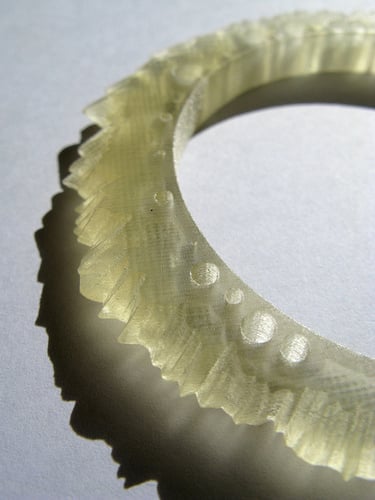
Mitchell Whitelaw’s Weather Bracelet is a stunning piece of wearable art. The 3D print visualizes one year of the weather data in Canberra. The outer edge is determined by the daily minimum and maximum temperatures. The holes indicate rainfall. I love this piece, both the look of it and its concept. Mitchell(
Mtchl on Shapeways) also has made the great Phase bracelet it is here in his Shop and you can see pictures of it on the forum here. Mitchell is one of a number of designers working with Processing to generate wonderful items on Shapeways. You can see more Processing art here. You can see more photos of the Weather Bracelet in Mitchell’s photostream and read his blog here.
Joris: Why did you make the Weather Bracelet?
Mitchell Whitelaw: I’m interested in ways of manifesting data , making it tangible – visualization, but also other forms. Data-sculpture isn’t an original
idea, I’m inspired by others including Andreas Nicholas Fischer and Fluidforms.
I’m also interested in weather and climate (and the line between the
two) and how we can make long time-scales tangible – this relates to an
earlier project, Watching the Sky.

J: Where did you get the idea from? The data?
MW: Mostly the idea of wearable data – making abstract patterns literally
tangible. Also I’m a huge fan of Nervous System’s jewelry (http://n-e-r-v-o-u-s.com)
and have been watching their 3d printed work closely. A bracelet seemed
like a good template to use – I did an earlier experiment along those
lines. I also
have a thing for radial time-series, as in Watching the Sky. Then it
was a process of playing with forms – I used Processing to generate the
geometry from the data.
J: At what show are you going to exhibit it?
MW: It is called Beginning, Middle, End – at the School of Art Gallery, Australian National University, Canberra – opening 6pm Friday 18th September!
J: Is it actually going to be used as a bracelet?
MW: I hope so, it depends if anyone wants to wear it! The current form is
really a prototype; I’m planning to fabricate some different versions –
including a large one in cut paper. I’m also thinking about other
time-spans and locations, and the mass-customization approach that
people like Fluidforms are exploring.



We love interesting new ways to combine data visualization with products and 3D printing such as the Weather Bracelet. We also love examples of Co-Creation such as the models on our Co-Creator Platform gallery.
When an experienced community member c
From today until December 4th we will be having a Co-Create Christmas Contest for you. We had a huge number of entries for the Metal Inspiration contest and we hope for as many awesome models this time too! The combination of 3D printing technology and
Awesome bracelet.Really love the way combining data visualization with products and 3D printing.Your such a genius guys.
Britney